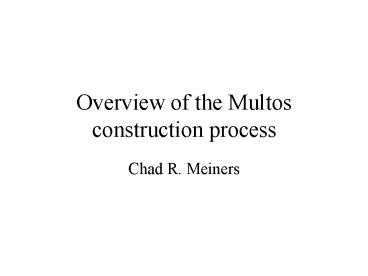Overview of the Multos construction process - PowerPoint PPT Presentation
Title:
Overview of the Multos construction process
Description:
Overview of the Multos construction process Chad R. Meiners Outline Examine the characteristics of Multos Examine the project requirements Examine the formal ... – PowerPoint PPT presentation
Number of Views:64
Avg rating:3.0/5.0
Title: Overview of the Multos construction process
1
Overview of the Multos construction process
- Chad R. Meiners
2
Outline
- Examine the characteristics of Multos
- Examine the project requirements
- Examine the formal methodology
- Examine the developmental results
- Evaluate Praxiss methods
- Evaluate the papers focus
- Evaluate infrastructural requirements of the
methodology
3
Multos
- Multos is a secure operating system for running
separate applications within a single smart card. - Multos depends on a centralized certification
authority to provide permission to load and
delete applications from a card. - Praxis was hired to develop the Multos
certification authority.
4
Project Requirements
- ITSEC level E6 certification
- Formal methods required
- System requirements must be unambiguous
- Minimum developmental risk
- Avoid pitfalls in later development cycles
- Keep within developmental and budget constraints
5
System Requirements
- COTS hardware and infrastructure
- Minimize the cost
- Minimize time
- Multi-user requirements
- System distributed for high throughput
- System must be usable to clients
- Security
- System must be trusted and usable
6
Methodology
- Correctness by construction depends on knowing
what the system needs to do and being sure that
it does it. - -Anthony Hall and Roderick Chapman
- Requirements
- Specification
- Design
- Code
7
Requirements
- Translated business objectives into requirements
- Labeled each requirement
- Traced each label to a source
- Includes tracing security requirements to threats
- Validate all requirements with the client
8
Specification
- System specified as a series of black boxes
- User Interface
- The look and feel of the black boxes
- Prototype verified by clients
- Formal top-level specification
- The functionality of the black boxes
- Typechecker used to verify and check system
consistency
9
High Level Design
- Described how the black boxes function together
- Described the black boxes internal structures
- Addressed security concerns between the boxes
10
Security with Untrusted Components
- System security must not really on the security
of untrusted components - Commercial database
- Untrusted operating system
- Security achieved by (from the paper)
- Hardware separation
- Information encryption
- Authentication codes
- Individual processing of security-critical code
11
Detailed Design
- Describes the actual software modules to
construct the system - Most modules are directly derived from the formal
top-level specification - Complex areas are further modeled in Z
- Key management
- System startup
12
Formal Security Policy Model
- Security requirements written in Z
- Four types of requirements
- Security invariants
- Functional requirements
- Operational constraints
- Information separation
- Requirements checked with a typechecker
13
Code
- Code life of twenty years
- Avoided using COTS software components
- Implemented these components from scratch
- Multiple languages used for appropriate jobs
- Spark Ada Security Kernel
- Ada 95 System critical parts
- C Reuse cryptography code
- C GUI
14
Review
- All artifacts of the development cycle were
reviewed and check for correctness and
consistency - Automated checking was used when possible
- Desk checking was performed when necessary
15
Testing
- System built incrementally in a top down fashion
- Each system test was a real system in the
environment - Tests derived from specifications and automated
- Tests were instrumented to check statement and
branch coverage
16
Results
- The delivered system satisfied client
requirements - Low defect rate in the system
- 0.04 defects per KLOC
- 100,000 line of code
- Minimized the amount of effort spent fixing
errors (6 of total effort)
17
Results of Tool Support
- Developers could concentrate on insuring correct
system wide behavior - Z automatically checked for consistency
- CSP model checked
- SPARK eliminated an entire domain of errors
- Tool support was utilized whenever available
18
But was it a commercial success?
- Mobile Communication
- Mobile e-Commerce
- Mass Transit
- CA in UK
- CA in Japan
- Future CA in Hong Kong
- Government Immigration card project
19
Other Praxis Projects
- SHOLIS
- Hercules II (C-130J) Flight Software Development
20
Praxiss Methodology
- Specify early specify often
- Black boxes
- Allows for the formalization of interfaces and
expectations - Works even for untrusted components
- Untrusted COTS components integrated via
incorporating the lack of trust in the system
design
21
Papers focus
- Concentrated on the developmental process of
incorporating various formal tools - Advocated the right tool for the right job
approach - Designed to demonstrate the approachability of
formal methods
22
Developmental Infrastructure
- Requires the developers commitment to the
approach - Personnel need to be trained in formal method
techniques before starting the project - Formal methods must be considered at every step
of the project - Must understand that FM is not a magic bullet
- Requires the clients acceptance of the approach
- Client must be willing to provide proper feedback
to the developers - Must understand that FM is not a magic bullet
23
So where do the formal methods for security fit
into this process?
- Used to model protocols before implementation
- Used to establish a set of trusted protocol for
use in formally developed systems - The methods we have learned so far must be
grafted into a real development process
24
References
- Anthony Hall and Roderick Chapman. Correctness by
construction Developing a commercial secure
system. IEEE Software, Jan/Feb18-25, 2002. - The Multos Website http//www.multos.com
- Praxiss SPARK Website http//www.sparkada.com
25
Thanks
- Zhenxiao Yang For questioning about the
commercial success of Multos - Brian Kellogg For questioning about the
existence of any bias in the paper































